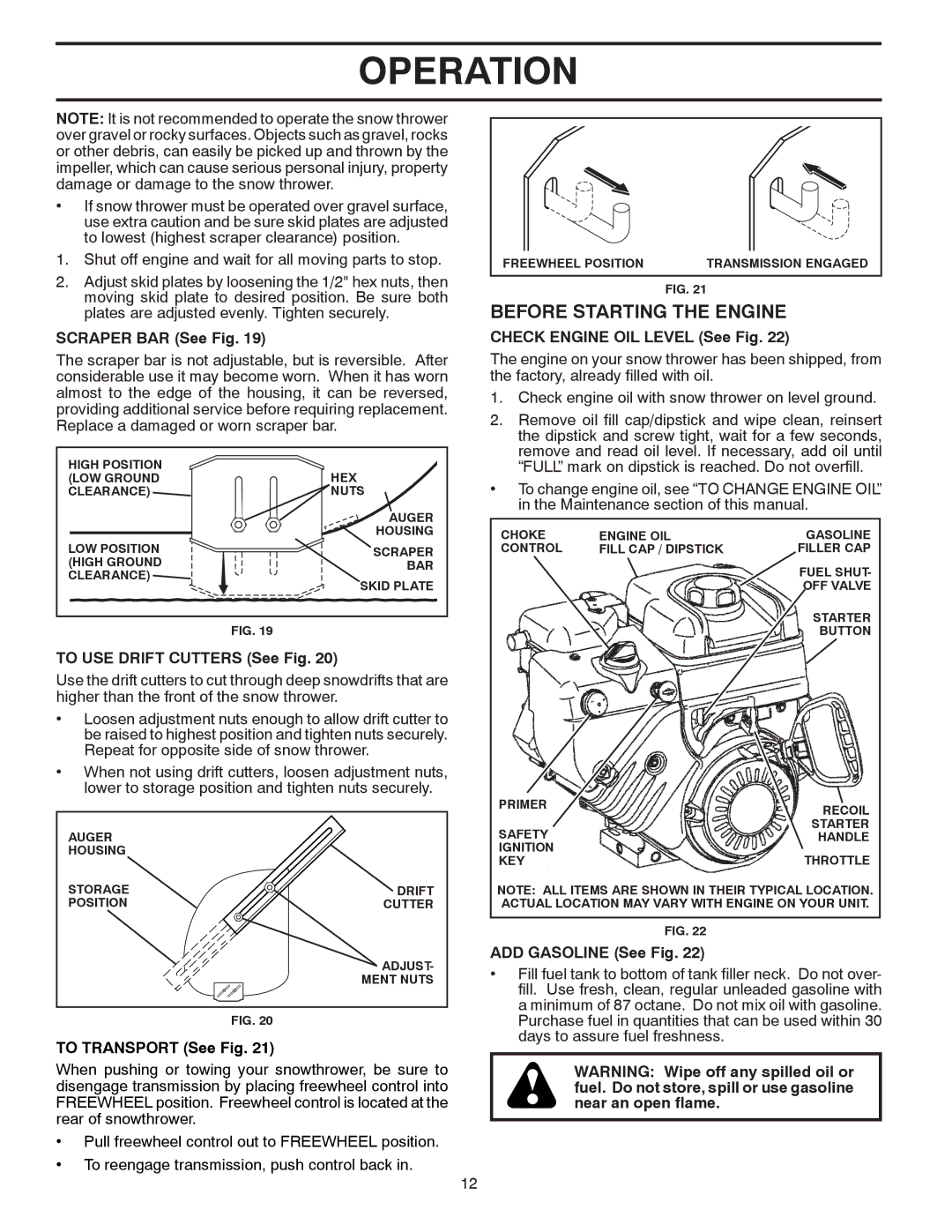
OPERATION
NOTE: It is not recommended to operate the snow thrower over gravel or rocky surfaces. Objects such as gravel, rocks or other debris, can easily be picked up and thrown by the impeller, which can cause serious personal injury, property damage or damage to the snow thrower.
•If snow thrower must be operated over gravel surface, use extra caution and be sure skid plates are adjusted to lowest (highest scraper clearance) position.
1.Shut off engine and wait for all moving parts to stop.
2.Adjust skid plates by loosening the 1/2" hex nuts, then moving skid plate to desired position. Be sure both plates are adjusted evenly. Tighten securely.
SCRAPER BAR (See Fig. 19)
The scraper bar is not adjustable, but is reversible. After considerable use it may become worn. When it has worn almost to the edge of the housing, it can be reversed, providing additional service before requiring replacement. Replace a damaged or worn scraper bar.
HIGH POSITION | HEX |
(LOW GROUND | |
CLEARANCE) | NUTS |
| AUGER |
| HOUSING |
LOW POSITION | SCRAPER |
(HIGH GROUND | BAR |
CLEARANCE) | SKID PLATE |
|
FIG. 19
TO USE DRIFT CUTTERS (See Fig. 20)
Use the drift cutters to cut through deep snowdrifts that are higher than the front of the snow thrower.
•Loosen adjustment nuts enough to allow drift cutter to be raised to highest position and tighten nuts securely. Repeat for opposite side of snow thrower.
•When not using drift cutters, loosen adjustment nuts, lower to storage position and tighten nuts securely.
AUGER
HOUSING
STORAGE | DRIFT |
POSITION | CUTTER |
ADJUST-
MENT NUTS
FIG. 20
TO TRANSPORT (See Fig. 21)
When pushing or towing your snowthrower, be sure to disengage transmission by placing freewheel control into FREEWHEEL position. Freewheel control is located at the rear of snowthrower.
•Pull freewheel control out to FREEWHEEL position.
•To reengage transmission, push control back in.
FREEWHEEL POSITION | TRANSMISSION ENGAGED |
FIG. 21
BEFORE STARTING THE ENGINE
CHECK ENGINE OIL LEVEL (See Fig. 22)
The engine on your snow thrower has been shipped, from the factory, already filled with oil.
1.Check engine oil with snow thrower on level ground.
2.Remove oil fill cap/dipstick and wipe clean, reinsert the dipstick and screw tight, wait for a few seconds, remove and read oil level. If necessary, add oil until “FULL” mark on dipstick is reached. Do not overfill.
•To change engine oil, see “TO CHANGE ENGINE OIL” in the Maintenance section of this manual.
CHOKE | ENGINE OIL | GASOLINE |
CONTROL | FILL CAP / DIPSTICK | FILLER CAP |
|
| FUEL SHUT- |
|
| OFF VALVE |
|
| STARTER |
|
| BUTTON |
PRIMER | RECOIL |
| |
SAFETY | STARTER |
HANDLE | |
IGNITION | THROTTLE |
KEY |
NOTE: ALL ITEMS ARE SHOWN IN THEIR TYPICAL LOCATION. ACTUAL LOCATION MAY VARY WITH ENGINE ON YOUR UNIT.
FIG. 22
ADD GASOLINE (See Fig. 22)
•Fill fuel tank to bottom of tank filler neck. Do not over- fill. Use fresh, clean, regular unleaded gasoline with a minimum of 87 octane. Do not mix oil with gasoline. Purchase fuel in quantities that can be used within 30 days to assure fuel freshness.
WARNING: Wipe off any spilled oil or fuel. Do not store, spill or use gasoline near an open flame.
12
